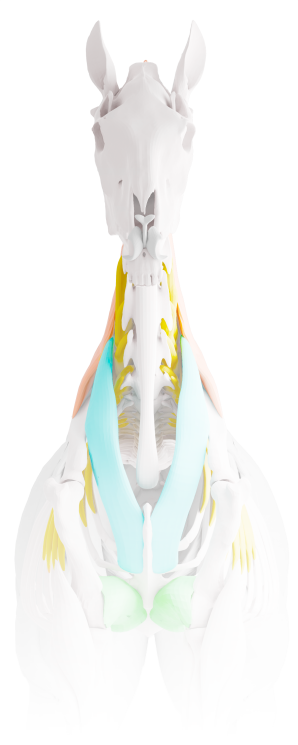
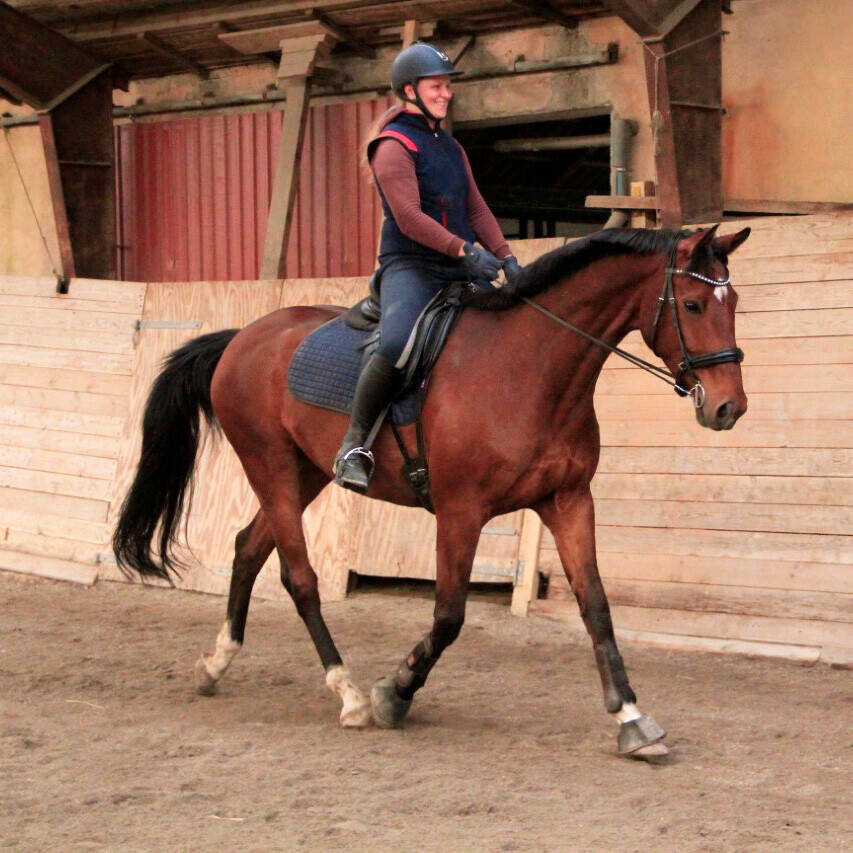
Jeannette Glerup Skaarup is the author of this article. She runs the company Healthy & Durable Riding Horses by Jeannette Glerup. She is a trained physiotherapy equine therapist from the Center for Veterinary Therapy in 2015, BBH basic instructor from Blue Berry Hill in 2015 and BBH trainer specializing in therapeutic training also from Blue Berry Hill in 2019.
She offers one-on-one tuition, courses, and lectures - both in person and online.
The horse cannot tell the difference
Your horse doesn’t know the difference between whether it’s the one who "goes on the reins" or whether it’s you who are making the half halt. It simply feels a pressure in its mouth or on the back of its nose. It’s your job as a rider to be clear that the horse must slow down when the pressure on the rein or the back of the nose becomes sufficient. By being clear about the difference between "being on the rein" and "slow down", you can work towards an easier, softer, and more stable contact with your horse
To dare to let the horse find its balance point
It can be difficult to dare to give the horse a long rein and "see what happens". You might only get a few steps before you have to shorten the reins again to make a new half halt. It’s only natural that your horse needs to find the coordination and build strength and balance.
Once the horse is in good horizontal balance, you may find that it moves its head all the way down to the bottom of the riding arena or picks its head up when you give in to the reins. This is only natural because it is testing its new balance point. If the horse has any kind of tension in the top line, a stretch that moves through the body and down towards the bottom of the arena will help to relax the back of the horse's top line and release the tension. This doesn’t mean that your horse should stay long and deep, but it should be seen as a tool to relax the horse's top line. You can see it as an "active break".
Two ways to offer contact
It’s important that you offer your horse contact on the reins properly. Because this contact is a constant thing you offer you horse. But how should it actually feel? All in all, there are two images you can keep in your head - or two emotions you can try to feel - when you ride.
1. The young birds
Imagine that your reins are like two little young birds that you have to take care of. You should hold on to them so that you are sure that they don’t fly away but stay with you. However, they must also not be squeezed and must be able to breathe effortlessly. That’s how gentle your rein contact should feel and be offered to the horse.
2. The water hose
Imagine the feeling of water from a water hose flowing out from your arms and into the horse's mouth. Even with half halts and rein-backs, you should still have this feeling. Your rein contact should be straight and uninterrupted from your elbow, going down through your forearm, your hands, via the rein and out to the horse's mouth. You need to have the feeling that the reins are simply extensions of your arms and that you are in direct contact with the bit rings with your hands.
Play with tempo changes
When you feel that your horse can maintain a good horizontal - and vertical - balance, you can test it through tempo changes. But you should only do this when the horse can continue at the same pace, direction, and balance when you extend the reins.
If you notice that the horse is “falling apart” or starting to stabilize in the lower neck as you increase the pace, then you know it was too much pace for now. Then you should help the horse return to its horizontal balance and test again where approximately the limit of the pace is. Move between the horse's normal work pace and up to the limit to practice balance and lifting of the back.
Similarly, you can work at a slower pace. Here, your horse must also be cohesive, even if the pace slows down. Again, the horse can manage to keep the balance by stabilizing on the lower neck muscles, which we do not want. Therefore, it is always a balancing act between the different tempi. What is too little, too much and just right is therefore something you must test and challenge when you want to help your horse into its horizontal balance.
Help the horse into balance
If the horse tends to be heavy on the forehand or walk with its head high, there’s often a lot to be gained by helping it into horizontal balance. When this happens, it gives the horse better working conditions to be able to form the rainbow shape down from the neck base.
In the training, you should therefore pay close attention to the horse’s balance point. It should be in such a way, that you can extend the rein fully and still feel your horse staying in pace, rhythm, and balance. The goal is for the horse to be able to maintain its own balance, both horizontally and vertically. That you’re your horse will be generally lighter on the reins
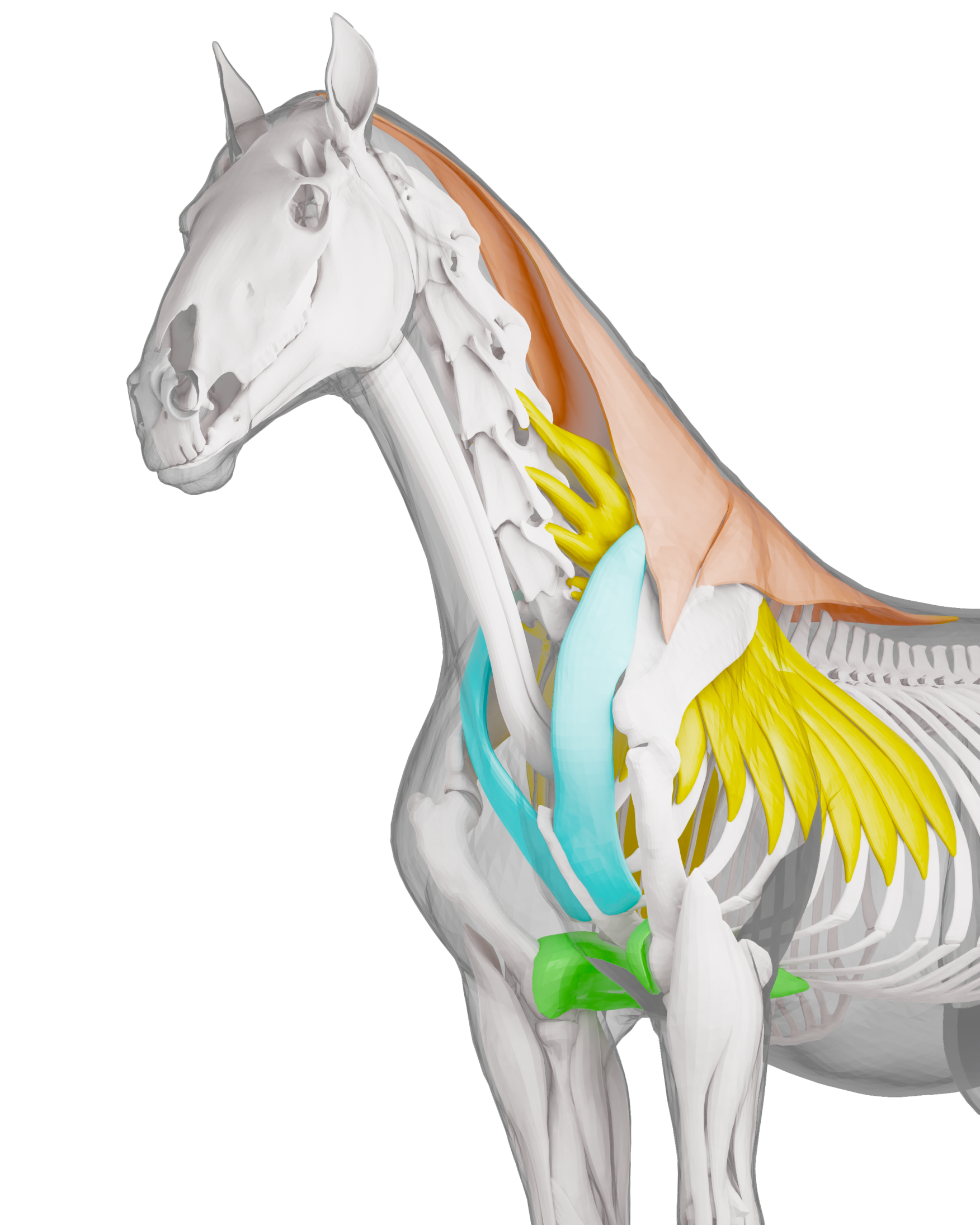
Let your horse walk with its head as it pleases and feel how it carries its head. This is an expression of what is happening elsewhere in the body. If you notice that the horse is starting to go faster, it’s probably because it’s heavy in the forehand and trying to “catch up with its horizontal balance point”. This can lead the horse move even faster because the horizontal balance point is always further ahead than the horse itself.
Help your horse by making a half halt on both reins. You must do this to form a connection between the reins and the horse's chest muscles, which are part of the thoracic sling, where the horse's horizontal balance stems from.
As soon as you notice that your horse is slowing down as a result of the half halt, you release the pressure. You may find that the horse picks up the pace as soon as you give into the reins.
Again, ask your horse to slow down on both reins. You can combine the half halt with an exhalation and even ride at a slower pace. For example, slow down your pace when you rise for the trot, so that the horse has an easier time finding the desired pace.
It’s important that you release on both reins as soon as your horse slows down - even if your horse increases the pace again shortly after. By releasing every time your horse slows down, you show it that it was the right behavior it responded with when it felt the half halt on both reins. The goal is that your horse can keep pace and direction even if you extend the reins.
You can test the horse's vertical balance as part of the daily training by letting your horse trot on a long rein. Follow the steps below.
Test and train the horse's balance
The horse is heavy on the forehand and the goal is to get its horizontal balance point back. When the horse is forehand heavy, it creates more tension in the bottom line, which becomes long (green). The topline becomes short (blue), creating a lowered thoracic sling that pushes into the ground (red). The general expression in the head is tension (white). This signals that the horse doesn’t appreciate the training at this moment.

The horse is in balance and steps more under itself with its hind legs. The top line is smooth, and the push comes from behind (blue). The horse's bottom line is active (green), as a natural part of its movement. The thoracic sling is pulled up (red) and helps to fill the hole at the withers. The general expression in the head is relaxed and shows that the horse is comfortable (white).

The neck is a balance bar
If your horse is too heavy on the forehand, it will be in horizontal imbalance. To compensate, it may choose to lift its head and neck, and its cervical vertebrae will form the natural s-curve, which makes it difficult - probably almost impossible - for it to lift its back.
For many riders this will result in an attempt to help the horse "back in the frame" of the rein, perhaps by using an auxiliary rein. From a biomechanical point of view, however, we don’t create relaxation or resilience in the horse by doing that, but we rather create tensions. If instead we remove the blockages in the horse's body, it can move more dynamically.
The bottom line is short, and the top line is long
When the horse moves on the forehand and with the head raised, the activity in its lower neck muscles increases, which will result in tension in an attempt to keep the balance. It will have a "long" bottom line and a corresponding "short" top line. But to achieve a correct collection, we as riders should be interested in the horse achieving a “long” top line and a “short” bottom line. In other words, we want the horse to lift and stretch its back.
In order for the horse to be able to do this, we must, among other things, make it possible for the horse to lift itself inside the base of the neck. This is the transition at the sixth and seventh cervical vertebrae and the first and second thoracic / spinal vertebrae.
When the horse lifts from the neck base, it will change the shape of the neck vertebrae from the mentioned s-curve and create a rainbow shape. In addition, the horse will lift its thoracic sling and thus its rib cage and the front part of its back.
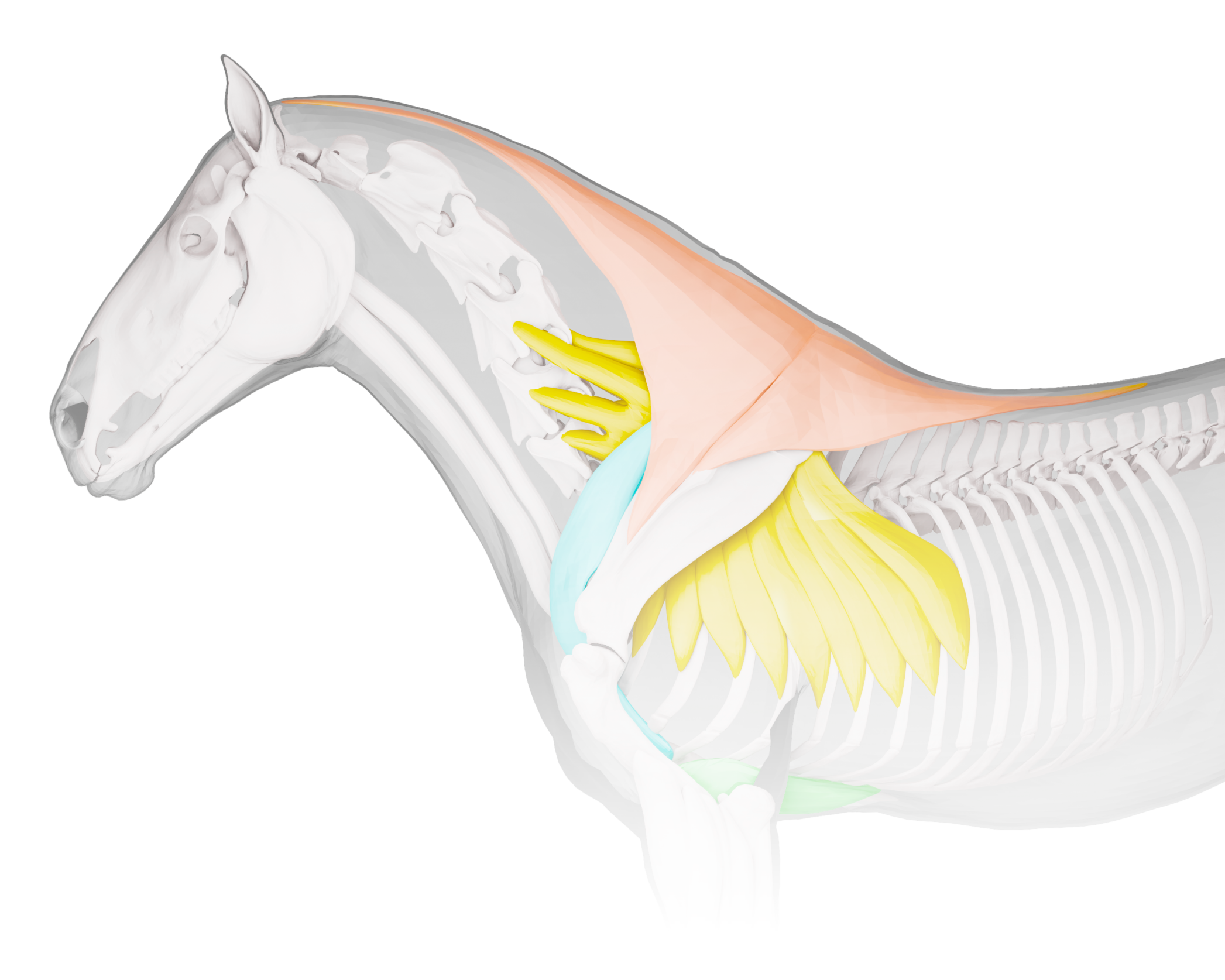
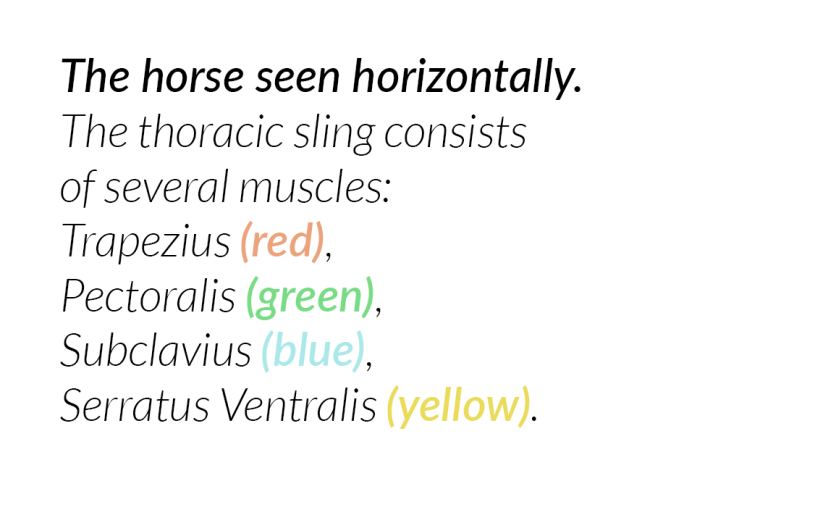
If we look at the horse's balance from a biomechanical point of view, there’s a horizontal and the vertical balance.
The horizontal balance is where we look at the horse from the side and look to see if it tends to be heavy on its forehand, whether it’s in balance and whether it works with collection throughout the body.
The vertical balance is where we see the horse straight from the front or from behind. Here we look at whether the horse is kind of tumbling in or out of a straight line. The vertical balance has a great impact on the horse's ability to remain straight with its front and hind legs and to keep its shoulders in place during training. Knowledge of the horizontal and vertical balance provides insight into the horse's general ability to balance itself and move optimally through the body.
THE THORACIC SLING
The thoracic sling is also called the chest sling and is intended, among other things, to have a shock-absorbing effect. It consists exclusively of muscles, tendons, and connective tissue from the rib cage and out to the horse's front legs. Because the horse has no collarbone, the thoracic sling is very flexible, and the forehand can change in all directions depending on whether the horse has tensions or is asymmetric in its muscles.
Depending on the horse’s tension or muscle asymmetry, it can pull the thoracic sling forward. This leads to a horizontal imbalance and the horse's rib cage can make a rotation which can cause a vertical imbalance. The vertical imbalance is often expressed by the horse subordinating one or both front legs.
Insecurity can create problems in the forehand
If your horse is uneasy about something in its environment, it’s only natural for it to get tensed. In many cases, it might also raise its head, which can lead to the rib cage being lowered. This increases the weight of the thoracic sling and can create horizontal imbalance with more weight on the forehand.
If your horse is insecure about something in his surroundings, it’s important that you as a rider recognize that your horse doesn’t feel comfortable and that you help it become more confident.
The worst thing we as riders can do is push the horse when it becomes insecure. It will just confirm for the horse, that something unpleasant or dangerous is happening and it can set off a real negative spiral.
There are a wide range of options for making your horse feel comfortable in its surroundings. What works best, of course, depends on the situation and the individual horse. Let your horse approach new things gradually and accept if it finds some things difficult. Make room for it to keep its distance, ride with a distance and then gradually approach the “scary” thing.
Meanwhile, you can check in and pay attention to signals from the horse showing that it is starting to feel more comfortable.
If the horse is tensed because it’s insecure about its surroundings, it will have a hard time understanding the actual training. At the same time, it will move with an elevated level of tension, which doesn’t benefit a healthy movement. Therefore, it’s important to ensure that your horse feels safe in its “workspace” before focusing on working at creating a healthy movement as a riding horse.


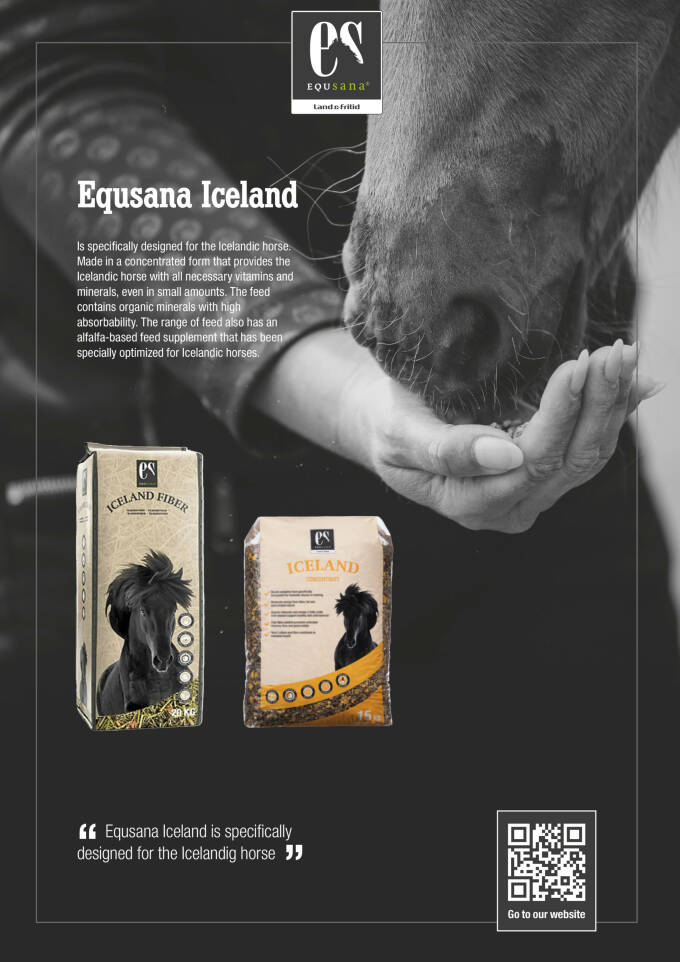
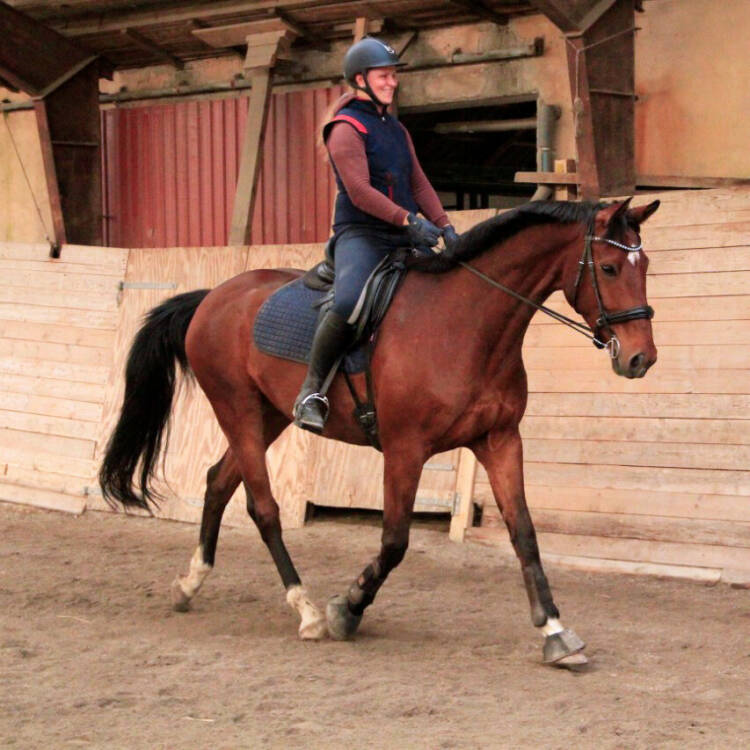
Jeannette Glerup Skaarup is the author of this article. She runs the company Healthy & Durable Riding Horses by Jeannette Glerup. She is a trained physiotherapy equine therapist from the Center for Veterinary Therapy in 2015, BBH basic instructor from Blue Berry Hill in 2015 and BBH trainer specializing in therapeutic training also from Blue Berry Hill in 2019.
She offers one-on-one tuition, courses, and lectures - both in person and online.
The horse cannot tell the difference
Your horse doesn’t know the difference between whether it’s the one who "goes on the reins" or whether it’s you who are making the half halt. It simply feels a pressure in its mouth or on the back of its nose. It’s your job as a rider to be clear that the horse must slow down when the pressure on the rein or the back of the nose becomes sufficient. By being clear about the difference between "being on the rein" and "slow down", you can work towards an easier, softer, and more stable contact with your horse
To dare to let the horse find its balance point
It can be difficult to dare to give the horse a long rein and "see what happens". You might only get a few steps before you have to shorten the reins again to make a new half halt. It’s only natural that your horse needs to find the coordination and build strength and balance.
Once the horse is in good horizontal balance, you may find that it moves its head all the way down to the bottom of the riding arena or picks its head up when you give in to the reins. This is only natural because it is testing its new balance point. If the horse has any kind of tension in the top line, a stretch that moves through the body and down towards the bottom of the arena will help to relax the back of the horse's top line and release the tension. This doesn’t mean that your horse should stay long and deep, but it should be seen as a tool to relax the horse's top line. You can see it as an "active break".
Two ways to offer contact
It’s important that you offer your horse contact on the reins properly. Because this contact is a constant thing you offer you horse. But how should it actually feel? All in all, there are two images you can keep in your head - or two emotions you can try to feel - when you ride.
1. The young birds
Imagine that your reins are like two little young birds that you have to take care of. You should hold on to them so that you are sure that they don’t fly away but stay with you. However, they must also not be squeezed and must be able to breathe effortlessly. That’s how gentle your rein contact should feel and be offered to the horse.
2. The water hose
Imagine the feeling of water from a water hose flowing out from your arms and into the horse's mouth. Even with half halts and rein-backs, you should still have this feeling. Your rein contact should be straight and uninterrupted from your elbow, going down through your forearm, your hands, via the rein and out to the horse's mouth. You need to have the feeling that the reins are simply extensions of your arms and that you are in direct contact with the bit rings with your hands.
Play with tempo changes
When you feel that your horse can maintain a good horizontal - and vertical - balance, you can test it through tempo changes. But you should only do this when the horse can continue at the same pace, direction, and balance when you extend the reins.
If you notice that the horse is “falling apart” or starting to stabilize in the lower neck as you increase the pace, then you know it was too much pace for now. Then you should help the horse return to its horizontal balance and test again where approximately the limit of the pace is. Move between the horse's normal work pace and up to the limit to practice balance and lifting of the back.
Similarly, you can work at a slower pace. Here, your horse must also be cohesive, even if the pace slows down. Again, the horse can manage to keep the balance by stabilizing on the lower neck muscles, which we do not want. Therefore, it is always a balancing act between the different tempi. What is too little, too much and just right is therefore something you must test and challenge when you want to help your horse into its horizontal balance.
Help the horse into balance
If the horse tends to be heavy on the forehand or walk with its head high, there’s often a lot to be gained by helping it into horizontal balance. When this happens, it gives the horse better working conditions to be able to form the rainbow shape down from the neck base.
In the training, you should therefore pay close attention to the horse’s balance point. It should be in such a way, that you can extend the rein fully and still feel your horse staying in pace, rhythm, and balance. The goal is for the horse to be able to maintain its own balance, both horizontally and vertically. That you’re your horse will be generally lighter on the reins
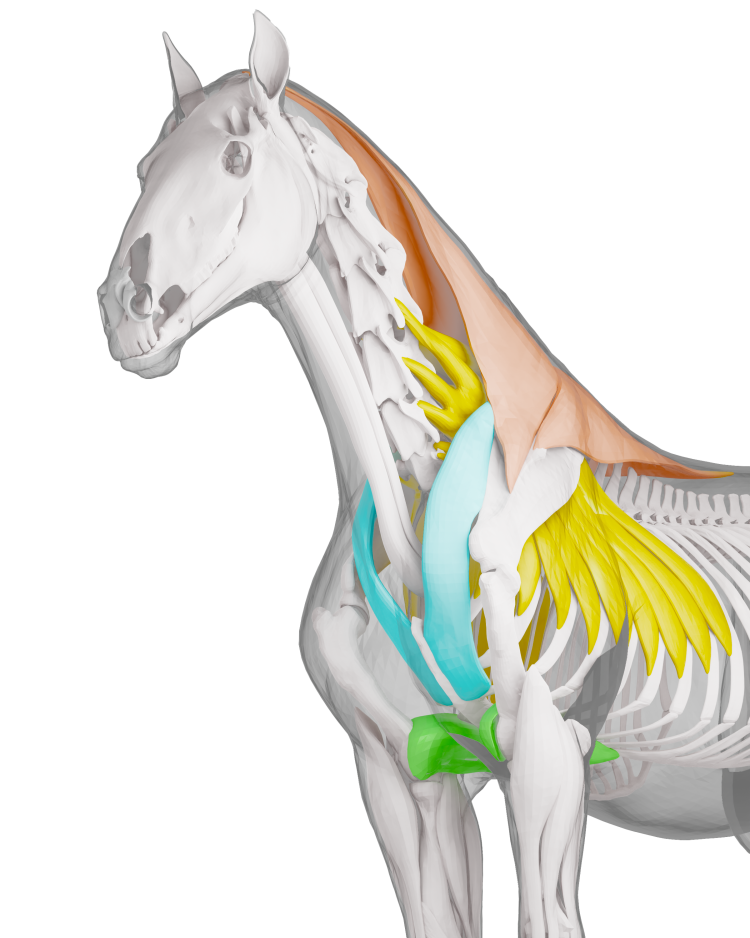
Let your horse walk with its head as it pleases and feel how it carries its head. This is an expression of what is happening elsewhere in the body. If you notice that the horse is starting to go faster, it’s probably because it’s heavy in the forehand and trying to “catch up with its horizontal balance point”. This can lead the horse move even faster because the horizontal balance point is always further ahead than the horse itself.
Help your horse by making a half halt on both reins. You must do this to form a connection between the reins and the horse's chest muscles, which are part of the thoracic sling, where the horse's horizontal balance stems from.
As soon as you notice that your horse is slowing down as a result of the half halt, you release the pressure. You may find that the horse picks up the pace as soon as you give into the reins.
Again, ask your horse to slow down on both reins. You can combine the half halt with an exhalation and even ride at a slower pace. For example, slow down your pace when you rise for the trot, so that the horse has an easier time finding the desired pace.
It’s important that you release on both reins as soon as your horse slows down - even if your horse increases the pace again shortly after. By releasing every time your horse slows down, you show it that it was the right behavior it responded with when it felt the half halt on both reins. The goal is that your horse can keep pace and direction even if you extend the reins.
You can test the horse's vertical balance as part of the daily training by letting your horse trot on a long rein. Follow the steps below.
Test and train the horse's balance
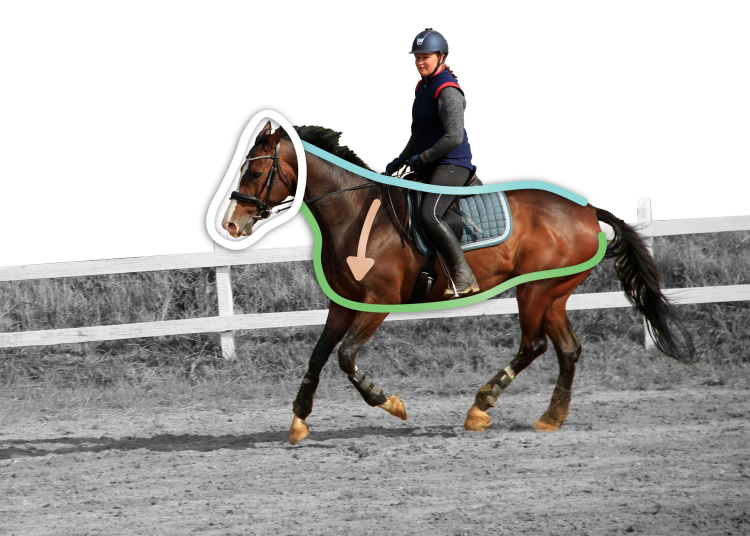
The horse is heavy on the forehand and the goal is to get its horizontal balance point back. When the horse is forehand heavy, it creates more tension in the bottom line, which becomes long (green). The topline becomes short (blue), creating a lowered thoracic sling that pushes into the ground (red). The general expression in the head is tension (white). This signals that the horse doesn’t appreciate the training at this moment.
The horse is in balance and steps more under itself with its hind legs. The top line is smooth, and the push comes from behind (blue). The horse's bottom line is active (green), as a natural part of its movement. The thoracic sling is pulled up (red) and helps to fill the hole at the withers. The general expression in the head is relaxed and shows that the horse is comfortable (white).
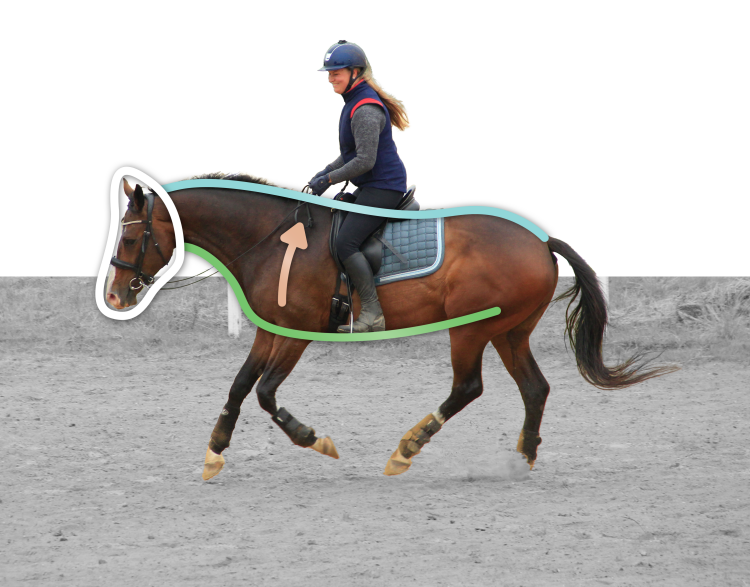
The neck is a balance bar
If your horse is too heavy on the forehand, it will be in horizontal imbalance. To compensate, it may choose to lift its head and neck, and its cervical vertebrae will form the natural s-curve, which makes it difficult - probably almost impossible - for it to lift its back.
For many riders this will result in an attempt to help the horse "back in the frame" of the rein, perhaps by using an auxiliary rein. From a biomechanical point of view, however, we don’t create relaxation or resilience in the horse by doing that, but we rather create tensions. If instead we remove the blockages in the horse's body, it can move more dynamically.
The bottom line is short, and the top line is long
When the horse moves on the forehand and with the head raised, the activity in its lower neck muscles increases, which will result in tension in an attempt to keep the balance. It will have a "long" bottom line and a corresponding "short" top line. But to achieve a correct collection, we as riders should be interested in the horse achieving a “long” top line and a “short” bottom line. In other words, we want the horse to lift and stretch its back.
In order for the horse to be able to do this, we must, among other things, make it possible for the horse to lift itself inside the base of the neck. This is the transition at the sixth and seventh cervical vertebrae and the first and second thoracic / spinal vertebrae.
When the horse lifts from the neck base, it will change the shape of the neck vertebrae from the mentioned s-curve and create a rainbow shape. In addition, the horse will lift its thoracic sling and thus its rib cage and the front part of its back.
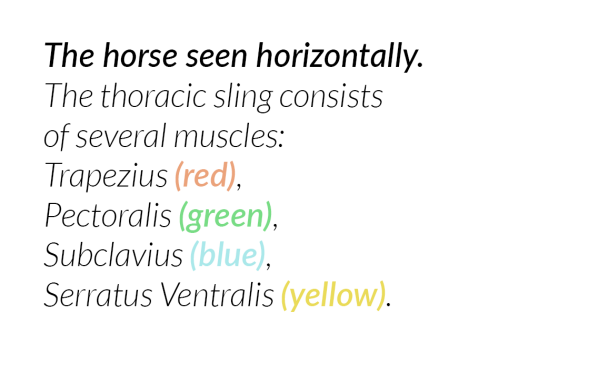

If we look at the horse's balance from a biomechanical point of view, there’s a horizontal and the vertical balance.
The horizontal balance is where we look at the horse from the side and look to see if it tends to be heavy on its forehand, whether it’s in balance and whether it works with collection throughout the body.
The vertical balance is where we see the horse straight from the front or from behind. Here we look at whether the horse is kind of tumbling in or out of a straight line. The vertical balance has a great impact on the horse's ability to remain straight with its front and hind legs and to keep its shoulders in place during training. Knowledge of the horizontal and vertical balance provides insight into the horse's general ability to balance itself and move optimally through the body.
THE THORACIC SLING
The thoracic sling is also called the chest sling and is intended, among other things, to have a shock-absorbing effect. It consists exclusively of muscles, tendons, and connective tissue from the rib cage and out to the horse's front legs. Because the horse has no collarbone, the thoracic sling is very flexible, and the forehand can change in all directions depending on whether the horse has tensions or is asymmetric in its muscles.
Depending on the horse’s tension or muscle asymmetry, it can pull the thoracic sling forward. This leads to a horizontal imbalance and the horse's rib cage can make a rotation which can cause a vertical imbalance. The vertical imbalance is often expressed by the horse subordinating one or both front legs.
Insecurity can create problems in the forehand
If your horse is uneasy about something in its environment, it’s only natural for it to get tensed. In many cases, it might also raise its head, which can lead to the rib cage being lowered. This increases the weight of the thoracic sling and can create horizontal imbalance with more weight on the forehand.
If your horse is insecure about something in his surroundings, it’s important that you as a rider recognize that your horse doesn’t feel comfortable and that you help it become more confident.
The worst thing we as riders can do is push the horse when it becomes insecure. It will just confirm for the horse, that something unpleasant or dangerous is happening and it can set off a real negative spiral.
There are a wide range of options for making your horse feel comfortable in its surroundings. What works best, of course, depends on the situation and the individual horse. Let your horse approach new things gradually and accept if it finds some things difficult. Make room for it to keep its distance, ride with a distance and then gradually approach the “scary” thing.
Meanwhile, you can check in and pay attention to signals from the horse showing that it is starting to feel more comfortable.
If the horse is tensed because it’s insecure about its surroundings, it will have a hard time understanding the actual training. At the same time, it will move with an elevated level of tension, which doesn’t benefit a healthy movement. Therefore, it’s important to ensure that your horse feels safe in its “workspace” before focusing on working at creating a healthy movement as a riding horse.
